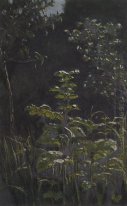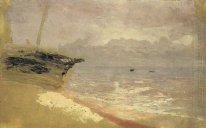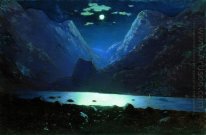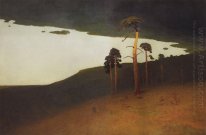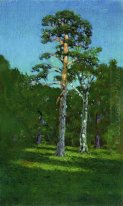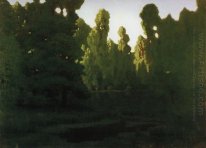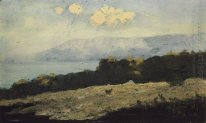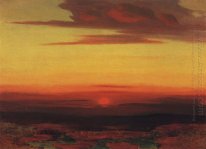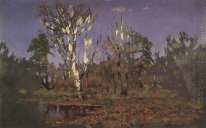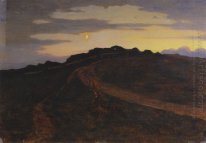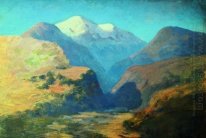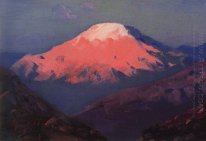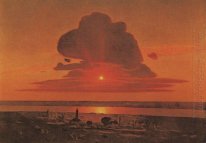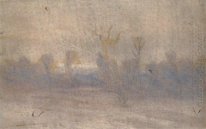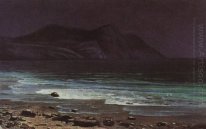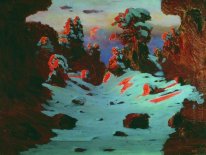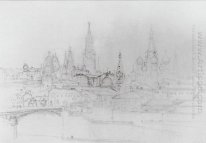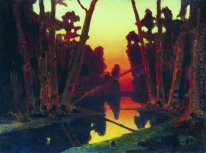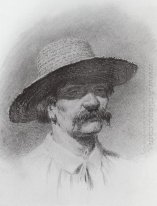Arkhip Kuindzhi

Arkhip Ivanovich Kuindzhi was a highly regarded Russian (Ukrainian) landscape painter and a member of the amazing group of Russian painters known as the Peredvizhniki (“Itinerants” or “Wanderers”, see my related posts).Kuindzhi was noted for his unorthodox compositions and daring experiments with lighting effects, perhaps partly stemming from his limited formal training.
Arkhip Kuindzhi was born in January 1841 in Mariupol (Ukraine), but he spent his youth in the city of Taganrog. He grew up in a poor family, and his father was a Greek shoemaker. Arkhip was six years old when he lost his parents, so that he was forced to make his living, working at the church building site, grazing domestic animals, and working at the corn merchant's shop. During five years, from 1860 to 1865, Arkhip Kuindzhi worked as retoucher in the photo studio of Isakovich in Taganrog. Kuindzhi tried to open his own photographer's studio, but without success. After that Arkhip Ivanovich Kuindzhi left Taganrog for Saint Petersburg.
He studied painting mainly independently and in Saint Petersburg Academy of arts (from 1868; the full member since 1893). He was co-partner of mobile art exhibitions or "Peredvizhniki" ("The Wanderers"), a group of Russian realist artists who in protest to academic restrictions formed an artists' cooperative, which evolved into the Society for Traveling Art Exhibitions in 1870. During early period Kuinzhy felt Ivan Aivazovsky's influence. In 1872 the artist left Academy and worked as a freelance. The panting "Na ostrove Valaam" ("On the Valaam Island") was the first artwork, which Pavel Tretyakov acquired for his art gallery. In 1873, Kuindzhi exhibited his new painting "The Snow", which received the bronze medal at the International Art Exhibition in London in 1874. In the middle of 1870's he created a number of paintings in which the landscape motive was designed for concrete social associations in spirit of Peredvizhniki ("Forgotten village", 1874; "Chumatski path", 1875; both - in Tretyakov gallery).
In his mature period Kuindzhi aspired to transfer the most expressive on illumination of a condition of the nature. He applied composite receptions (high horizon, etc.), allowing creation of panoramic views. Using light effects and the intensive colors shown to several main tones, he achieved almost full illusion of illumination ("The Ukrainian night", 1876; "Birchwood", 1879; "After a thunder-storm", 1879; all three are in Tretyakov Gallery; "Night on Dnepr", 1880 in Russian museum, St.Petersburg). His later works are remarkable by decorative effects of color building. He lectured at the Saint Petersburg Academy of Arts (Professor in 1892; since 1894 Professor-Head of landscape workshop; but he was fired in 1897 for support of student's protests). Among his students were such great artists as: L.A. Rylov, Nicholas Roerich, K.F. Bogaevsky, and others. Kuindzhi initiated creation of the Society of artists (1909; later - the Society named after A.I. Kuindzhi).
The contemporaries remember Kuindzhi as a short-tempered, but kind man. He was kind of greedy for fame, but often donated anonymously to charity. He and his wife lived in a house in the center of the city, and did all the household duties by themselves, without hiring any servants. Kuindzhi, especially in his later years, liked birds - tamed them and nursed them in ill health. Kuindzhi died of old age and is buried in the Tikhvinskoye Cemetery in St. Petersburg.
Antonello da Messina is, in a sense, the first truly European painter and his remarkably varied achievements raise issues crucial to our understanding of European art. No other Italian artist of the fifteenth century responded in such a direct fashion not only to the leading masters of Bruges and Brussels—Jan van Eyck (d. 1441) and Petrus Christus(d. 1475/76) in particular—but also to giants of French Proven?al painting such as the Master of the Aix Annunciation and Enguerrand Quarton.
Antonello da Messina was born around 1431, Antonello’s artistic career began in the lively cultural climate of the Aragonese court in Naples, at that time one of the centres of the Mediterranean civilization. The painter Colantino was active in this city at the time, and it was in his workshop that Antonello did his early training, receptive to the many stimuli offered by an environment in which Catalan and Proven?al works were to be found, along with Northern- European masterpieces such as the extraordinaryLomellini Triptych by Jan van Eyck.
His debut came with paintings like the Salting Madonnaand the enigmatic Portrait of a Man, from Cefalù. These were followed, between 1473 and 1474, by works that were already fully mature, the two most important being the Annunciation from Syracuse, where the lighting effects in the intricate spatial composition are handled with complete mastery, and the Saint Gregory Polyptych, commissioned for the church of the Benedictine Convent of Santa Maria Outside the Walls, with its highly innovative psychological rendering of the figures.
But it was Antonello’s period in Venice, from 1475 to 1476, which marked the definitive turning point in his artistic career and in fifteenth-century Italian art history. The encounter between Antonello’s art and the Venetian figurative environment, represented primarily by Giovanni Bellini, created the conditions necessary for absolute masterpieces, particularly portraits such as the so-calledCondottiere in the Louvre or the male portraits held by the National Gallery in London and the Galleria Borghese in Rome. Here, the typically Flemish characteristics such as the three-quarter pose, the parapet separating the subject from the viewer, the trompe l’oeil cartellino and the dark ground, are combined with a psychological rendering made unique and groundbreaking by its profound insight.
Antonello was immediately recognized as a great artist in Venice and received many prestigious commissions, including the one for the San Cassiano Altarpiece, painted in 1476 for the aristocrat Pietro Bon. This work immediately became famous for its wealth of precious details, and was executed in direct relation to contemporary works by Bellini.
During his stay in Venice, which was brief but marked by a series of masterpieces each more stunning than the other, the Sicilian painter developed the Ecce Homo theme in works of remarkable emotional intensity that move the viewer by humanizing Christ’s suffering with agonized realistic details. He also painted such gems as the small panel of Saint Jerome in his Study, with its dazzling spatial composition and unusual setting of a Renaissance study in a church aisle immersed in penumbra, and the small votive panels of Crucifixions from Antwerp and London. A crescendo of formal innovations and an unprecedented degree of viewer involvement peak in theVirgin Annunciate, from Palermo, in which a maiden, enveloped in her mantle, both hieratic and conscious of her role in the history of humanity, makes time stand still with her raised hand, and casts the viewer as the annunciating angel. The Salvator Mundi from London, second only to the Virgin Annunciate for the spatial virtuosity in the representation of the hands, and the so-called Trivulzio Portrait from Turin, a truly fine example of the characterization in Antonellian portraits, in which the sitter captures the viewer with his hypnotic and wickedly challenging gaze, were executed in 1476.
The Sicilian painter’s artistic career culminated in two exceptional works: the Saint Sebastian, from Dresden, commissioned during a plague epidemic, in which the master’s skill in creating perspective reaches its height in the Venetian cityscape, and the Pietà, from the Prado in Madrid, probably executed after his return to Sicily, since buildings that actually existed in Messina can be glimpsed in the background.
On 14 February 1479 , Antonello made his will, and died two months later. Thus ended an extraordinary artistic career in which converged with unusual consistency and intensity – like sunrays seen through a converging lens – the different cultural roots that intertwined in the Mediterranean during that period of splendor known as the fifteenth century.





